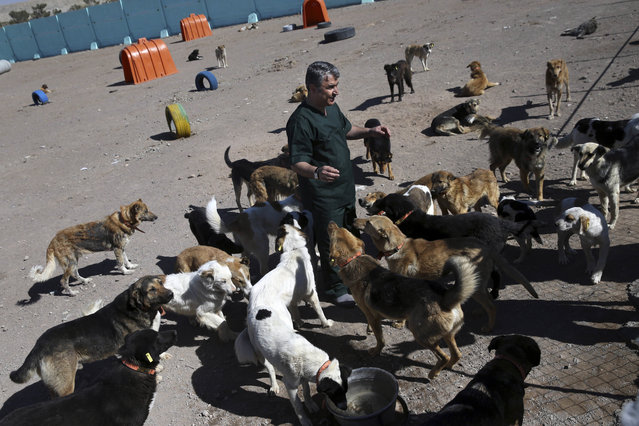
In this picture taken on Sunday, March 5, 2017, veterinarian Hamid Ghahremanzadeh, chief of Aradkouh Stray Dogs Shelter plays with some of his charges on the outskirts of the capital Tehran, Iran. On a cold winter morning in the Iranian capital recently, a homeless dog lay basking in the sun's rays for warmth. Suddenly, the canine moaned – it had been shot with an anesthetic dart from a blowpipe. It ran several steps, then fell immobilized. The cream-and-gray colored dog was collected by a worker for a new shelter where it will be given a medical check, neutered and microchipped – the first such initiative in this country where usually strays in the street are killed. The facility is equipped with surgery rooms, sonography machines and a kitchen. On a recent day, there were 500 mature dogs and 145 puppies being looked after by the shelter's staff. All the dogs are available for adoption. The Aradkouh Stray Dogs Shelter has been hired by the Tehran city government to take a new, more humane approach to deal with the burgeoning problem of stray dogs in the capital. It's a sign of changing attitudes among officials in a country where Islamic authorities have long seen dogs as “un-Islamic” and at times still confiscate them from people who have dogs as pets and walk them in public or drive with them in their cars. In Islam, dogs are seen as unclean. However, police dogs, shepherd dogs and rescue dogs are common, and there have been no reports of clerical backlash against the shelter's operations. Prior to the shelter's arrival, the preferred method of dealing with stray animals was to shoot them dead. In one horrific case in 2015, dogs were injected with a deadly substance, presumably acid. Videos were published on social media showing dogs dying while moaning in agony. The videos quickly went viral, sparking widespread outrage and prompting protests by animal rights activists and celebrities. An animal activist who filmed the dog killings in the city of Shiraz in central Iran claimed that private contractors were paid about $4 for each dog they killed. Local authorities denied having any role in the incident. Since the advent of the shelter, municipal authorities claim that not a single dog is killed inhumanely and that the animals are being treated in a far more civil manner. After shooting the dogs with the darts, the animals are placed in the air-conditioned rear compartments of the dog-catcher vehicles. Upon arrival at the shelter, after being fed and checked for illness, some dogs are neutered or treated with medicine in the facility's clinic and can spend 15 to 45 days there recovering. The dogs are then given to animal supporters who adopt them or are released into the wild. Dogs that are not adopted receive a collar and a microchip that contains the dog's full history. (Photo by Vahid Salemi/AP Photo)
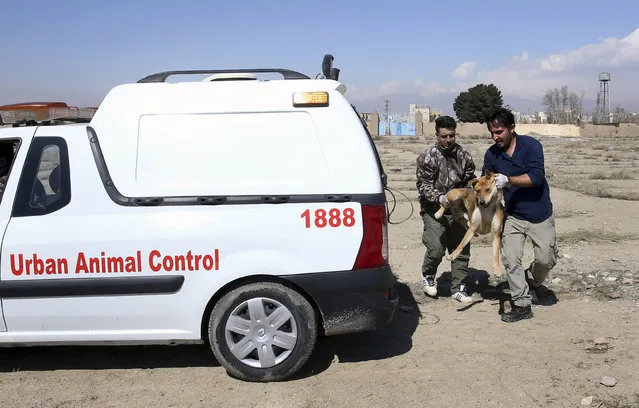
In this picture taken on Sunday, March 5, 2017, Tehran's urban animal control workers carry a caught stray dog to put into their vehicle after being shot with an anesthetic dart on the outskirts of the capital Tehran, Iran. The shelter has been hired by the Tehran city government to take a new, more humane approach to deal with the burgeoning problem of stray dogs in the capital. It’s a sign of changing attitudes among officials in a country where Islamic authorities long saw dogs as “un-Islamic” and would at times confiscate them from people who kept them as pets. (Photo by Vahid Salemi/AP Photo)
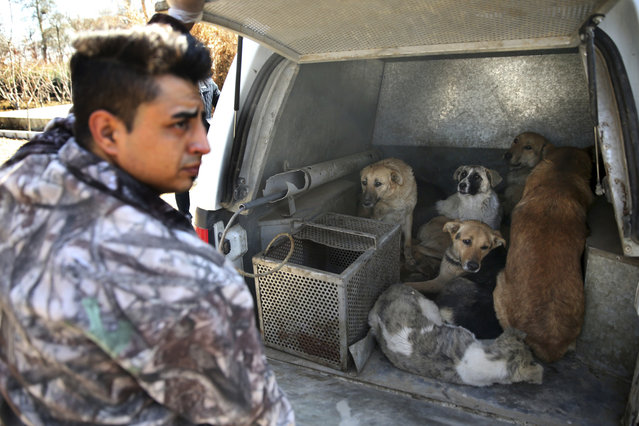
In this picture taken on Sunday, March 5, 2017, caught stray dogs are put inside the vehicle of Tehran's urban animal control after being shot with anesthetic darts on the outskirts of the capital Tehran, Iran. (Photo by Vahid Salemi/AP Photo)
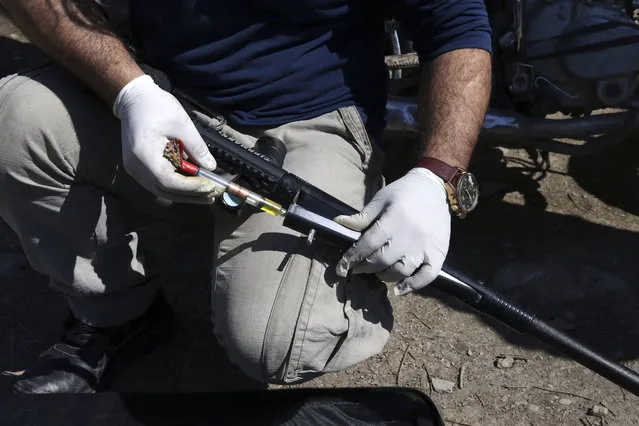
In this picture taken on Sunday, March 5, 2017, a Tehran urban animal control worker puts an anesthetic dart syringe into his gun to shoot stray dogs on the outskirts of the capital Tehran, Iran. (Photo by Vahid Salemi/AP Photo)
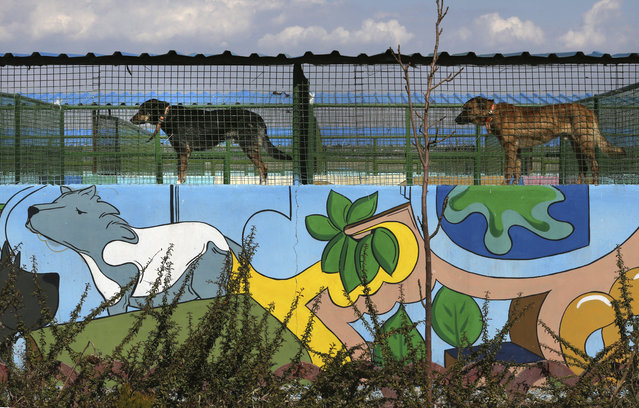
In this picture taken on Sunday, March 5, 2017, caught stray dogs stand on their cage's wall at Aradkouh Stray Dogs Shelter on the outskirts of the capital Tehran, Iran. (Photo by Vahid Salemi/AP Photo)
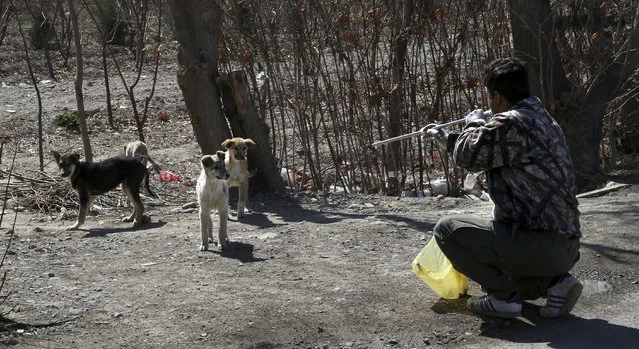
In this picture taken on Sunday, March 5, 2017, a Tehran urban animal control worker shoots dog with anesthetic dart from a blowpipe on the outskirts of the capital Tehran, Iran. (Photo by Vahid Salemi/AP Photo)
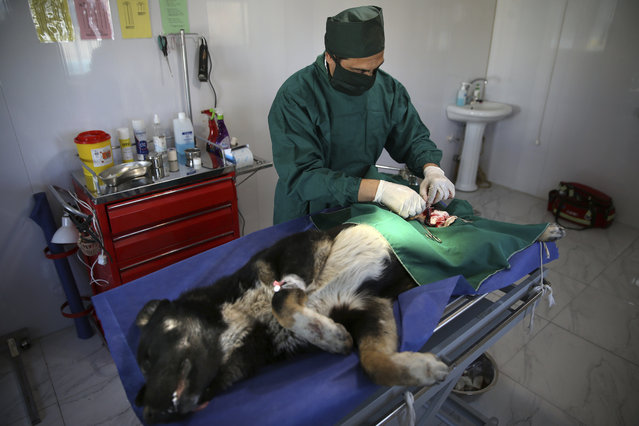
In this picture taken on Sunday, March 5, 2017, veterinarian Habib Golzardi performs a sterilization surgery on a stray dog at Aradkouh Stray Dogs Shelter on the outskirts of the capital Tehran, Iran. (Photo by Vahid Salemi/AP Photo)
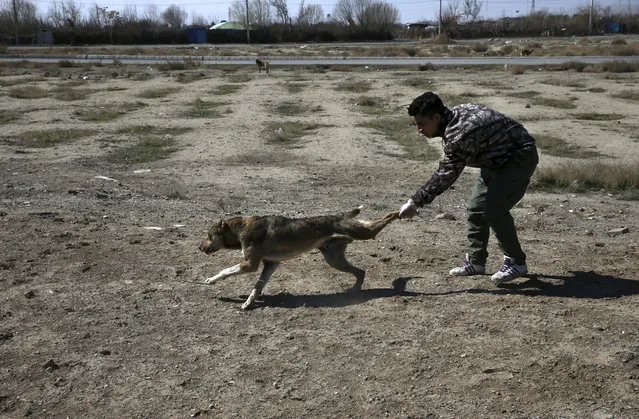
In this picture taken on Sunday, March 5, 2017, a Tehran's urban animal control worker catches a stray dog after being shot with his anesthetic dart on the outskirts of the capital Tehran, Iran. (Photo by Vahid Salemi/AP Photo)
17 Mar 2017 00:03:00,
post received
0 comments
